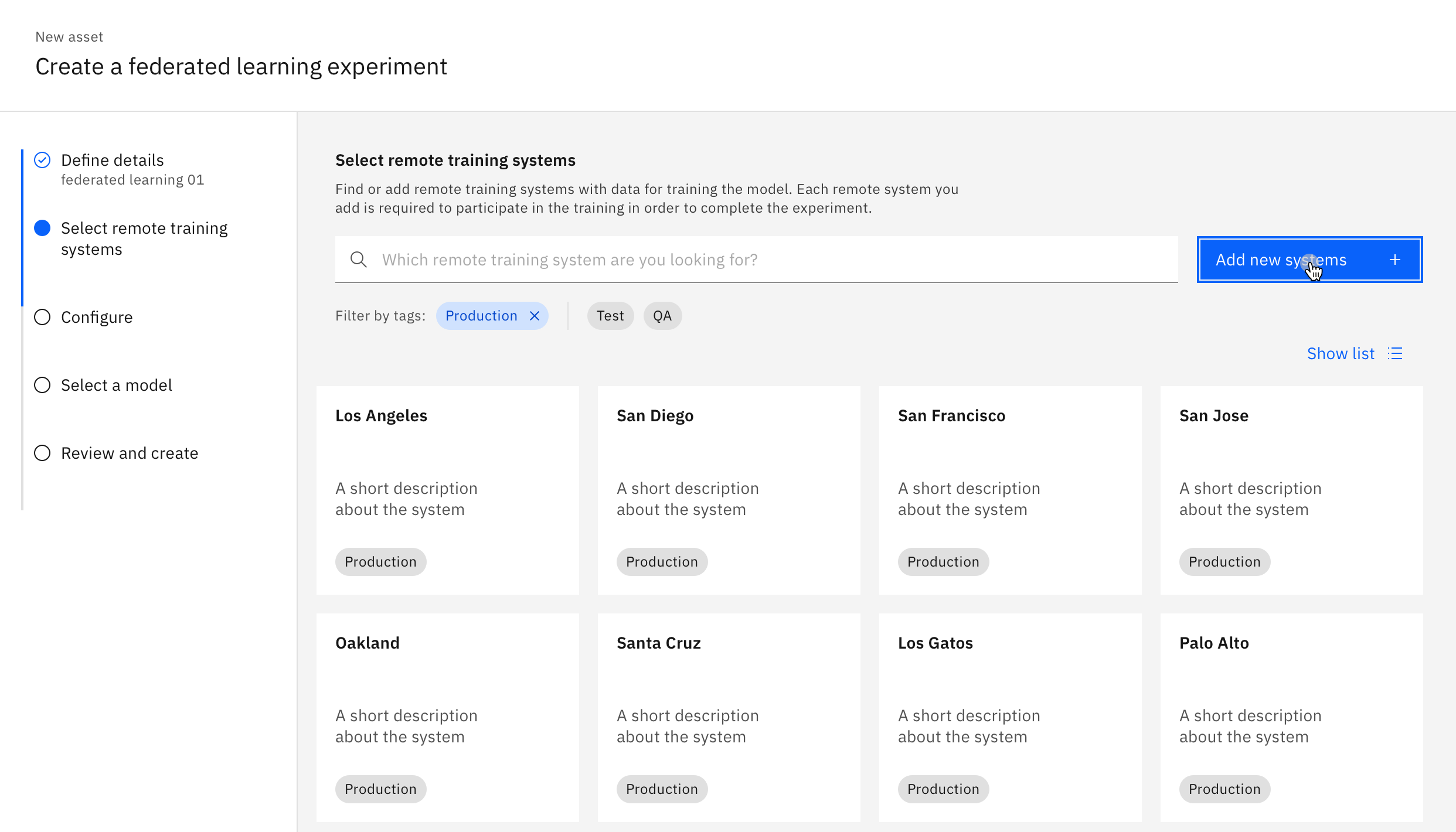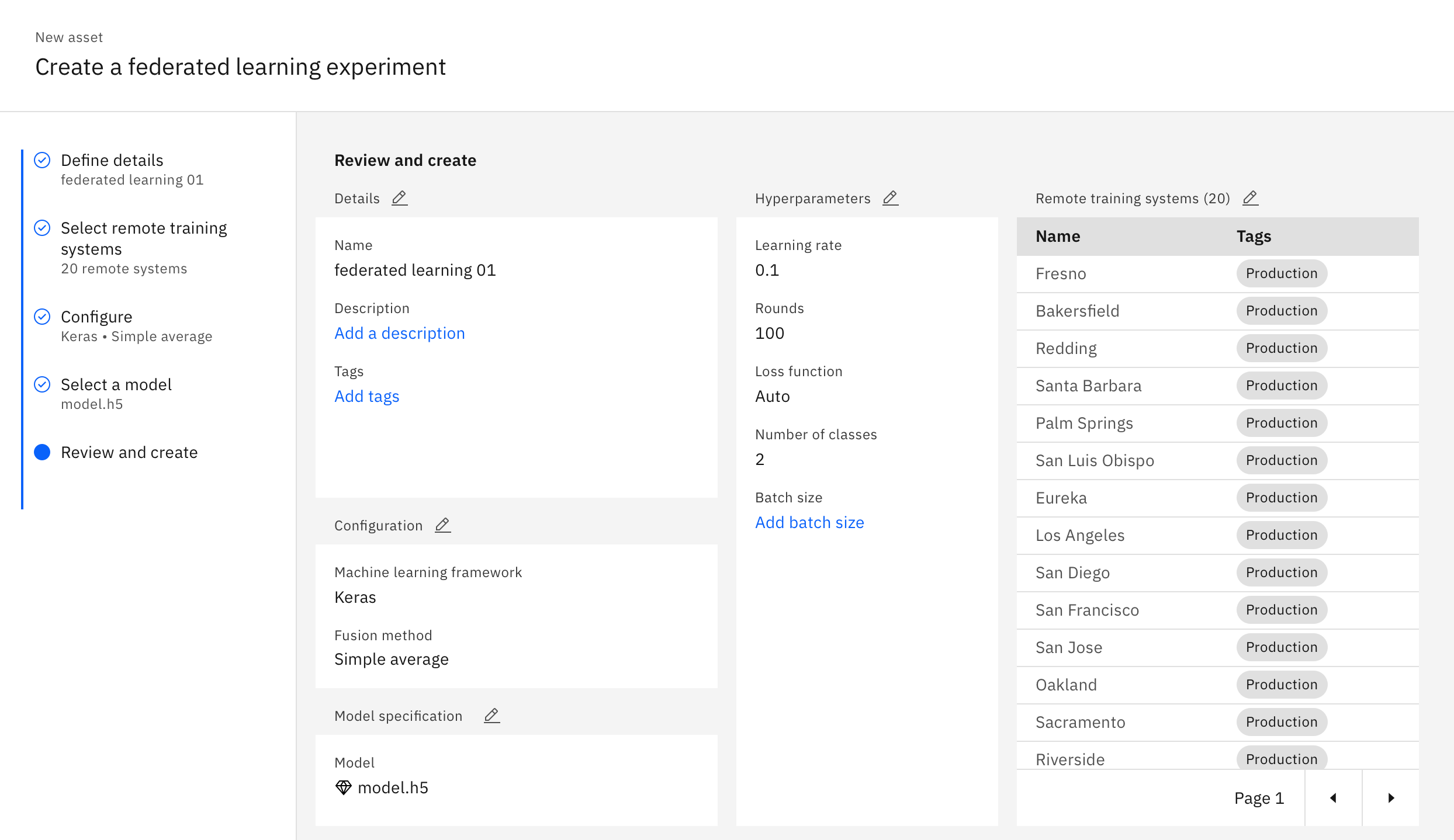An administrator completes the following steps to start the experiment and train the global model.
- Step 1: Set up the Federated Learning experiment
- Step 2: Create the remote training system
- Step 3: Start the experiment
Step 1: Set up the Federated Learning experiment
Set up a Federated Learning experiment from a project.
- From the project, click New asset > Train models on distributed data.
- Name the experiment.
Optional: Add an optional description and tags. - Add new collaborators to the project.
- In the Configure tab, choose the training framework and model type. See Frameworks, fusion methods, and Python versions for a table listing supported frameworks, fusion methods, and their attributes. Optional: You can choose to enable the homomorphic encryption feature. For more details, see Applying encryption.
- Click Select under Model specification and upload the
.zipfile that contains your initial model. - In the Define hyperparameters tab, you can choose hyperparameter options available for your framework and fusion method to tune your model.
Step 2: Create the Remote Training System
Create Remote Training Systems (RTS) that authenticates the participating parties of the experiment.
-
At Select remote training system, click Add new systems.

-
Configure the RTS.
Configuring the RTS Field name Definition Example Name A name to identify this RTS instance. Canada Bank Model: Federated Learning ExperimentDescription
(Optional)Description of the training system. This Remote Training System is for a
Federated Learning experiment to train a model for
predicting credit card fraud with data from Canadian banks.System administrator
(Optional)Specify a user with read-only access to this RTS. They can see system details, logs, and scripts, but not necessarily participate in the experiment. They should be contacted if issues occur when running the experiment. Admin ([email protected])Allowed identities List project collaborators who can participate in the Federated Learning experiment training. Multiple collaborators can be registered in this RTS, but only one can participate in the experiment. Multiple RTS's are needed to authenticate all participating collaborators. John Doe ([email protected])Jane Doe ([email protected])Allowed IP addresses
(Optional)Restrict individual parties from connecting to Federated Learning outside of a specified IP address.
1. To configure this, click Configure.
2. For Allowed identities, select the user to place IP constraints on.
3. For Allowed IP addresses for user, enter a comma seperated list of IPs and or CIDRs that can connect to the Remote Training System. Note: Both IPv4 and IPv6 are supported.John
1234:5678:90ab:cdef:1234:5678:90ab:cdef: (John’s office IP), 123.123.123.123 (John’s home IP), 0987.6543.21ab.cdef (Remote VM IP)
Jane
123.123.123.0/16 (Jane's home IP), 0987.6543.21ab.cdef (Remote machine IP)Tags
(Optional)Associate keywords with the Remote Training System to make it easier to find. CanadaBankModelCreditFraud -
Click Add to save the RTS instance. If you are creating multiple remote training instances, you can repeat these steps.
-
Click Add systems to save the RTS as an asset in the project.
Tip: You can use an RTS definition for future experiments. For example, in the __Select remote training system__ tab, you can select any Remote Training System that you previously created. -
Each RTS can only authenticate one of its allowed party identities. Create an RTS for each new participating part(ies).
Step 3: Start the experiment
Start the Federated Learning aggregator to initiate training of the global model.
- Click Review and create to view the settings of your current Federated Learning experiment. Then, click Create.

- The Federated Learning experiment will be in
Pendingstatus while the aggregator is starting. When the aggregator starts, the status will change toSetup – Waiting for remote systems.
Parent topic: Creating a Federated Learning experiment